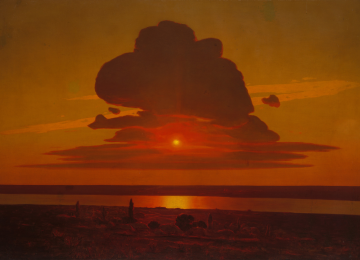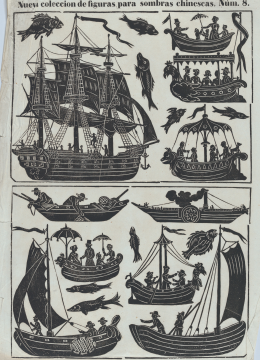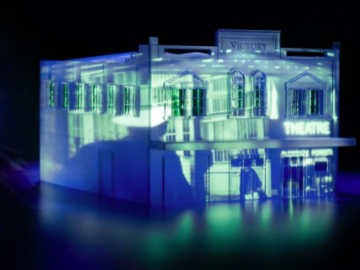The Visual Art of Writing or Krissy Kneen Carves out a Book
Kris Kneen
A parcel arrives for me express post. A heavy parcel. My partner is confused. He is used to seeing parcels arrive for me. Usually book-shaped boxes. This is different. It is heavy, irregularly shaped. Soft with the give of bubble wrap.
What have you ordered now?”
“A dress.” I tell him and he rolls his eyes. He watches me unwrap it. Under the layers of bubble wrap there is a green-grey rock. He nods. A rock.
“It’s for my new book,” I tell him.
Nothing surprises him now. After years of living with a writer he is no longer concerned about my search-history. He barely blinks when I buy a greenhouse and stack it with a dozen buckets filled with mycelium as research for yet another novel. The Rock is inexplicable but not exactly out of the ordinary.
This is how I write these days. I write into a book from the outside world, using found objects and craft projects as one might use words on a page. Writing for me has become an act of translation and to translate the world I need to immerse myself in it, digest it, and bring it back to the page. I am drawn to this image because the fiction book that I am working on involves mushrooms, spores from a newly discovered type of mushroom which have an impact on the people who breath them in. In my deep-dive into mycology I have noticed that the way mushrooms consume and transform the substrate is similar to the way in which I write. I spread out into the information I am gathering, lie in it just like strands of mycelium lie in their food, excreting enzymes which will break down their environment and make it digestible. Then they will take what they have eaten and become stronger, bigger and pass some of the energy on to other creatures in their networks through their hyphae.
When I am writing I surround myself with the material I need. I live in it, smell it, touch it, stare at it and then I digest it and transform it and somehow at the end of the process I will have a book.
This is how I used to paint. I would surround myself with materials, sometimes paints that weren’t really supposed to go together, oil paints with gouache, house paint with aquarelles, watercolours with estapol. The joy in painting was in combining things that shouldn’t really be put side by side. Sometimes it would be messy but often the combinations would be sublime.
I started life as an artist, I suppose we all do, moving food around on our plates and on our clothes till it looks and feels just right, digging in the sand and in the dirt to make sculpturally pleasing forms. But as the child growing up in my artist-grandmother’s house with a mother who painted and an aunt who made models, my early artistic efforts were nurtured. Deciding to be a writer was a kind of rebellion. There were no writers in my house. English was my grandmother’s fifth language. We were encouraged to read, surrounded by books but it was clear that we would end up being visual artists. It was the family trade. My grandmother said I would be a sculptor. She was the matriarch of our house and her control of us, her children and her grandchildren, was absolute. I would, indeed be a sculptor.
A sculptor uses many different mediums. Some people use clay, some use found objects, some use stone or metal. I use words, sentences, paragraphs chapters. The book takes shape, I feel the shape of it as I might feel the block of clay changing form under my hands. It is a bodily shift. The book lives in my body and I sculpt it out of my own flesh and the stuff of my life and onto the page.
The visual arts techniques that I grew up with were my first language. As soon as I was able to hold a brush without licking it I was given oil paints to work with on an old pre-stretched canvass. The canvasses were ones my mother or my aunt or my grandmother had already painted on. Abandoned projects. I could follow the pre-existing lines a kind of painterly colour-by-numbers, or I could completely obliterate the other image by adding my own lines over the top.
I learned to speak through colour, line and shape. I learned the subtle nuances of balance, harmony and texture. When I began to write I brought these elements of design with me. As a sculptor I brought the words out into the extra dimensions of touch, smell, sound, taste.
These days I can’t begin a book without a photograph, a painting or a sculptural form to guide me. Each one of my books has had an image at the heart of it. The image shapes more than the visual aspects of the work. I keep the image by my desk and come back to it as I work.
Line, shape, place, value, form, texture, colour, contrast, balance, repetition, harmony. The elements and principles of design can translate from an image to a written work.
The sentences provide the lines of the work you are writing. The lines could be clean, short, sharp, modern, free of adjectives, a fast line of text racing the reader towards a conclusion, or, like some of my favourite writers, Kerri Hulme or Michael Ondaatje, the line could be baroque, twisting, full of layered images.
The shape of your book will become obvious if you pull back from it, break the book down into chapters, perhaps write them on colour coded cards. More of one character’s journey in one part of the book, more fear, more joy, a swelling of faster and faster scenes ballooning out towards the end.
I know not everyone has had the benefit of growing up around visual arts but most people still have a distant memory of childhood experiments with crayons, mud or clay. Play is the central principle of any art. Play is what will bring you back to a visual experience of your own work. These early games are innate. Re-learning them is a simple matter of reawakening what was always there.
I run a writing workshop where participants use images in a number of ways. The first and easiest exercise is to pull an image randomly from a pile of pictures and to respond to these images as an artist would respond to a life-model changing pose. In life classes we start with a series of quick poses. These poses become longer and longer until there is a long pose, twenty minutes, or half an hour on the one scene.
Another way of looking at your work is to picture it as a map, a shape, a series of coloured shapes on a page. Make an imaginary map that includes, characters, parts of the plot, locations that feature in the work. This map can be added to, changed. It can include the characters’ backstories, things that haven’t and won’t make it in to the draft. As the map becomes richer so too will your connection to the work.
I have two current book projects, the novel that involves mushrooms, and a non-fiction book about fatness. My mushroom-castle greenhouse in the back courtyard is a living sculpture, reminding me of the shifts and changes that should be at the heart of that book. Each time a new bunch of yellow oyster mushrooms push out from a plastic bucket I nod, and say Oh yes! This is how the book will grow, one gorgeous fruit after another. I have captured the images of each bunch of mushrooms and store them in a folder. The ever-shifting forms are my guide for each bulging, succulent chapter in that manuscript.
I pick up the green soapstone and weigh it in my hand. It feels like a project that is ripe and ready to be honed. I know what I am going to make of it. I have been looking up pictures of stone Venus’s from pre-historic times, their swelling stomachs, breasts, hips. Their pronounced vulvas. I want to carve a series of Venus’s out of this stone, fat, sexy women who will accompany me on my journey towards the completion of my book on fatness. I am almost ready to dive in to that project in a full-bodily way. As I carve the women out of stone, so too will I carve my fat book out of the pages of notebook and translate them yet again to words on a screen. I am itching to start that book in earnest, all I need is a hammer and a chisel and a clear day in the quiet sunshine to hack my stone thoughts into some kind of sculptural order.
Feature image via JSTOR


